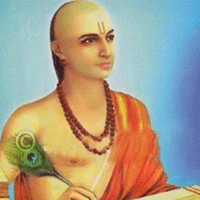Bhaskaracharya
The leading mathematician of the 12th century, who wrote the first work with full and systematic use of the decimal number system.
Bhaskaracharya’s father was a Brahman named Mahesvara. Mahesvara himself was famed as an astrologer. This happened frequently in Indian society with generations of a family being excellent mathematicians and often acting as teachers to other family members.
Bhaskaracharya became head of the astronomical observatory at Ujjain, the leading mathematical centre in India at that time. Outstanding mathematicians such as Varahamihira and Brahmagupta had worked there and built up a strong school of mathematical astronomy.
In many ways Bhaskaracharya represents the peak of mathematical knowledge in the 12th century. He reached an understanding of the number systems and solving equations which was not to be achieved in Europe for several centuries.Bhāskara II was the lineal successor of the noted Indian mathematician Brahmagupta (598–c. 665) as head of an astronomical observatory at Ujjain.
The six works by Bhaskaracharya are: Lilavati (The Beautiful) which is on mathematics; Bijaganita (Seed Counting or Root Extraction) which is on algebra; the Siddhantasiromani which is in two parts, the first on mathematical astronomy with the second part on the sphere; the Vasanabhasya of Mitaksara which is Bhaskaracharya’s own commentary on the Siddhantasiromani ; the Karanakutuhala (Calculation of Astronomical Wonders) or Brahmatulya which is a simplified version of the Siddhantasiromani ; and the Vivarana which is a commentary on the Shishyadhividdhidatantra of Lalla. It is the first three of these works which are the most interesting, certainly from the point of view of mathematics, and we will concentrate on the contents of these.
In Bhāskara II’s mathematical works (written in verse like nearly all Indian mathematical classics), particularly Līlāvatī (“The Beautiful”) and Bījagaṇita (“Seed Counting”), he not only used the decimal system but also compiled problems from Brahmagupta and others. He filled many of the gaps in Brahmagupta’s work, especially in obtaining a general solution to the Pell equation (x2 = 1 + py2) and in giving many particular solutions (e.g., x2 = 1 + 61y2, which has the solution x = 1,766,319,049 and y = 226,153,980; French mathematician Pierre de Fermat proposed this same problem as a challenge to his friend Frenicle de Bessy five centuries later in 1657). Bhāskara II anticipated the modern convention of signs (minus by minus makes plus, minus by plus makes minus) and evidently was the first to gain some understanding of the meaning of division by zero, for he specifically stated that the value of 3/0 is an infinite quantity, though his understanding seems to have been limited, for he also stated wrongly that a⁄0 × 0 = a. Bhāskara II used letters to represent unknown quantities, much as in modern algebra, and solved indeterminate equations of 1st and 2nd degrees. He reduced quadratic equations to a single type and solved them and investigated regular polygons up to those having 384 sides, thus obtaining a good approximate value of π = 3.141666.
In other of his works, notably Siddhāntaśiromaṇi (“Head Jewel of Accuracy”) and Karaṇakutūhala (“Calculation of Astronomical Wonders”), he wrote on his astronomical observations of planetary positions, conjunctions, eclipses, cosmography, geography, and the mathematical techniques and astronomical equipment used in these studies. Bhāskara II was also a noted astrologer, and, according to a legend first recorded in a 16th-century Persian translation, he named his first work, Līlāvatī, after his daughter in order to console her. He tried to determine the best time for Līlāvatī’s marriage by using a water clock consisting of a cup with a small hole in the bottom floating in a larger vessel. The cup would sink at the beginning of the correct hour. Līlāvatī looked into the water clock, and a pearl fell off of her clothing, plugging up the hole. The cup never sank, depriving her of her only chance for marriage and happiness. It is unknown how true this legend is, but some problems in Līlāvatī are addressed to women, using such feminine vocatives as “dear one” or “beautiful one.”

Bhaskaracharya
Date of Birth: 13 Nov 2025
Birth Place: 1114, Biddur, India
Proffession: mathematician
Nationality: India
Death: 1185, probably Ujjain


